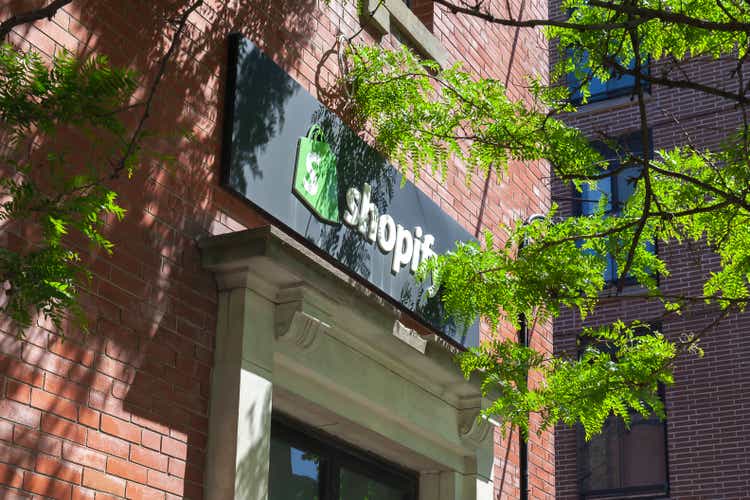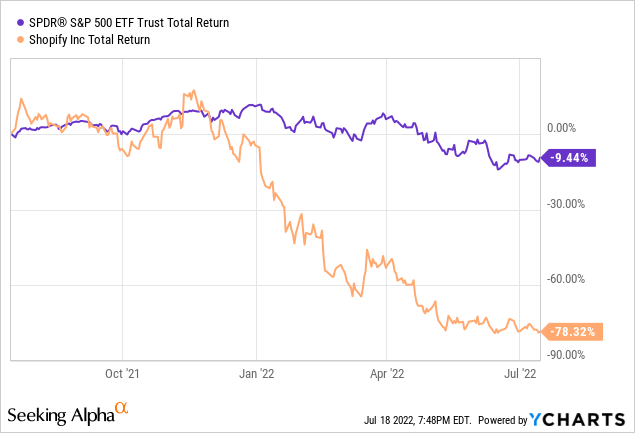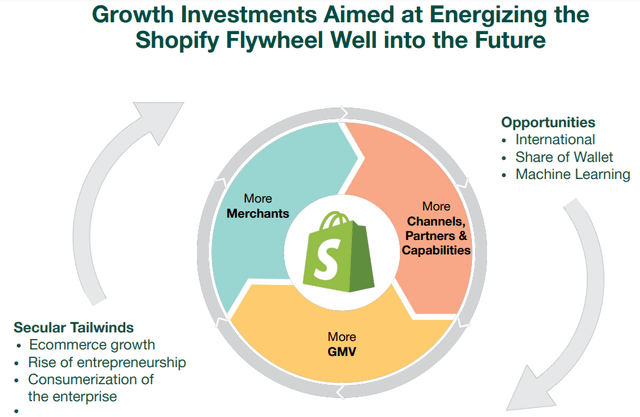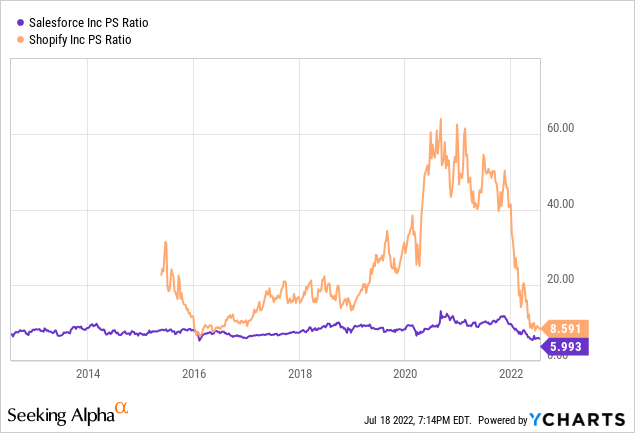JHVEPhoto
Shopify Inc. (NYSE:SHOP) is an innovative company in the ecommerce space, founded in 2006. While it benefited significantly from the COVID Pandemic in 2020 and 2021, the stock has been crushed (1-year return of -78%) by concerns about the macro-economical environment and slowing growth. I think the company still has a huge runway ahead, given its scale and platform advantages. Here I will share some of my thoughts as to why.

The digital infrastructure for commerce
If a merchant is interested in creating an online store, SHOP is the platform, acquiring 10.3% of market shares in U.S. retail ecommerce (right behind Amazon); there are more stores (1.7M) on SHOP than any other combined. According to the SHOP website:
Shopify Merchants Support World’s Largest Workforce, Contributing 5M Jobs and $444B+ in Economic Activity in 2021
In the early days, SHOP was mainly used for small and midsize businesses (SMBs). Many larger businesses joined Shopify Plus, which accounts for around 30% of sales. SHOP is an open ecosystem that truly supports merchants. As shown in the figure below, GMVs, merchants, channels, partners & capabilities all benefited from SHOP. The bigger SHOP gets, the more people want it to succeed.
SHOP Flywheel (SHOP presentation)
Monopoly in headless commerce and SMB services
SHOP runs headless commerce architecture where the front-end is decoupled from the back-end functionality. Therefore, its system can be updated or edited without interfering with the back-end, leading to good speed and simplicity as it scales. SHOP’s unparalleled quality and range of services on marketing, capital, payments, analytics, apps, inventory & fulfillment, order management, and shipping create a huge moat. SHOP takes care of all aspects of businesses along with hosting, updates, security, etc. Especially for SMBs who usually have no budget for development, SHOP is extremely easy and cost-efficient, which is almost a default option.
Regarding competitors, other players include Magento (or Adobe commerce), Miva, BigCommerce, WooCommerce, and WIX. They are either too difficult to use or lack enough scale to make an impact. BigCommerce might be the closest regarding tools and features, but its app network and customization features are not good enough. Magento is the most customizable one which may be attractive to larger merchants with a big development budget and a savvy developer in-house.
The amazing APP store and community support
One unique aspect of SHOP for its software offerings is its app ecosystem, which acts very much like Apple’s app store. As merchants heavily rely on the apps created by thousands of developers (who charge subscription fees to merchants), the switching cost is huge. Currently, there are 8k+ apps to fulfill all kinds of needs for merchants to do all types of tasks, such as loyalty programs, rewards, discounts, reviews, etc. A large number of experts and developers not only drive innovations on the platform but also help sell the SHOP platform, as 40K of partners referred at least one merchant to SHOP in the last 2021. There is also a wide range of partnerships with shipping companies, storage warehouses, marketing agencies, marketplaces, etc., along with the apps. SHOP makes money off those apps from subscription fees.
Customer relationship is the main differentiator
If your products are excellent, and you are trying to build your brand, you will start thinking about Shopify instead of marketplaces like eBay (EBAY), Amazon (AMZN), etc. One example was the breakup between Nike (NKE) and Amazon in 2019, and it was a good decision, according to a report:
The strategy is working because Nike is averaging 100 million visits to its website and is one of the top 10 most-downloaded shopping apps. As a result, Nike’s online sales were up 83% in the second quarter, adding $900 million to its total sales.
So even if businesses are selling on Amazon or eBay channels, they still would like to run stores with Shopify to own customer relations and consumer data on their products. SHOP’s promotion system is the most flexible one. You can run all kinds of discounts (e.g., buy 2 get 1), rewards, and credit points in a way that is intuitive and customized to your products. You could also create an AI-backed email and text messaging platform to target customers.
As SHOP scales, its platforms become the go-to option for social media sites as Instagram (META), Pinterest (PINS), and Facebook also need SHOP merchants to support their e-commerce business. These social media sites offer friendly access to the SHOP platform to do product listings, promotions, and checking seamlessly. Facebook and Instagram agreed to add the SHOP checkout button (a convenient one-click pay option) to their app. This payment option is currently on 50% of SHOP merchants, and consumers can track SHOP orders (even Amazon ones) through the Shop app.
Compete with Amazon
Amazon and SHOP are all customer-centric and serve many merchants using both services. They see each other as friends and competitors. Shopify offers great apps (all in one place) to help merchants automatically sync listings and manage sales on Amazon without leaving SHOP admin. Amazon’s “Buy with Prime” feature uses its payments and fulfillment services, which aim to take advantage of the checkout section on Shopify stores. Shoppers can use their Amazon Prime membership to receive fast shipping and other benefits. This is good for merchants, too, as they could very easily have their goods stocked at the Amazon warehouses and all the fulfillment handled by Amazon.
However, Amazon is very expensive and collects data from you. This is what SHOP doesn’t like. SHOP wants merchants to own their brands, keep their data, and save money. I think this is one of the major reasons behind the Deliverr acquisition. If SHOP can somehow fix fulfillment and have two-day or one-day delivery available, consumers do not have to compromise speed to use Prime Checkout. Of course, SHOP won’t be at the same level as Amazon in terms of logistics. As long as it is good enough for their enterprise-level customers (SMB can use outsourced logistics), they are successful. One risk is that this acquisition needs a long time to see its effect and requires a large capital investment.
In general, Amazon is like a department store or a mall. You are shopping with Amazon instead of the brands on Amazon. Amazon is the brand you are going after. Shopify is like the main street where you have the storefront of individual brands. Amazon offers hundreds of millions of shoppers. SHOP offers low fees, dropshipping, and marketing your own brands on social networks in the creator economy such as TikTok or Instagram.
Bottom line and risks
Overall, I think ecommerce is big enough and still growing fast for both Amazon and SHOP to thrive. As a much younger company, SHOP should have more space to monetize its user base and GMVs. For valuation, I don’t think Amazon is a good direct comparison with SHOP because of all other businesses such as AWS, Prime Videos, FireTV, etc.
Personally, I think Salesforce (CRM) should be a better one to check out for SHOP. Historically, CRM has had a stable growth rate of around 27% since the 2008 recession. Its P/S ratio has also been fairly stable in the range between 6x to 10x with a median of 8x. SHOP is a relatively younger business than CRM was in 2010. The current 8.5 PS should be a fair valuation.

Regarding the macro and market risks we are facing now, I think SHOP will do well in the end as an infrastructure-type business. The businesses SHOP is serving are actually high-quality brands which I think are much more resilient than others. For example, strong brands like Tesla (TSLA), Kylie Cosmetics, Los Angeles Lakers, PepsiCo (PEP), Red Bull, The New York Times (NYT) are all powered by SHOP.


Be the first to comment